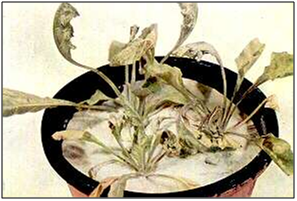Nickel
Nickel (Ni) is the 22nd abundant element in the earth crust and holds a special place among the heavy metals. Ni is an essential micronutrient for plant growth and it is also a component of the enzyme urease which is required for nitrogen metabolism in higher plants.
Source: https://www.ncbi.nlm.nih.gov/pmc/articles
Sources of Nickel
- Nickel is a ubiquitous trace metal emitted into the environment from both natural and anthropogenic which are found in soil, water and air samples within the biosphere.
- The compounds such as nickel acetate, nickel carbonate, nickel hydroxide and nickel oxide are used in a variety of industrial process.
- These compounds ultimately accumulate in the soil and environment, and can be easily taken up by plants. Thus, they can enter the food chain and cause deleterious effects to animals and human.
Inventory of nickel in various global environmental
| Compartment |
Mean concentration
(mg/kg) |
Nickel in compartment
(metric tons) |
| Lithosphere, down to 45 km |
75 |
4,300,000,000,000,000 |
| Sedimentary rocks |
48 |
120,000,000,000,000 |
| Soils, to 100 cm |
16 |
5,300,000,000,000 |
| Oil shale deposits |
30 |
1,400,000,000,000 |
| Dissolved oceanic |
0.0006 |
840,000,000 |
| Nickel ore reserves |
>2000 |
160,000,000 |
| Coal deposits |
15 |
150,000,000 |
| Terrestrial litter |
15 |
33,000,000 |
| Terrestrial plants |
6 |
14,000,000 |
| Suspended oceanic particulates |
95 |
6,600,000 |
| Crude oil |
10 |
2,300,000 |
| Terrestrial animals |
25 |
50,000 |
| Swamps and marshes |
7 |
42,000 |
| Lakes and rivers, total |
0.001 |
34,000 |
| Consumers/reducers (biological) |
3.5 |
11,000 |
| Atmosphere |
0.3 |
1,500 |
| Oceanic plants |
2.5 |
500 |
| Lakes and rivers, plankton |
4 |
230 |
Source: Int. J. Environ. Sci. Technol. (2016) 10:1129–1140
Source: https://link.springer.com/content/pdf/10.1007/s13762-013-0245-9.pdf
Nickel is delivered into the environment by several pathways:
- Factory waste of high-temperature technologies of ferrous and nonferrous metallurgy, cement clinker production, and burning liquid and solid fuels.
- Field irrigation with water high in heavy metal content and transfer of sewage residue into Soil.
- Transfer of heavy metals from mine tailings and metallurgical factories by water and air flows.
- Steady application of high rates of organic and mineral fertilizers and pesticides contaminated with heavy metals.
Source: Toxicity of Nickel in Plants, Int. J. Pure App. Biosci. 3 (2): 345-355 (2015)
Nickel deficiency
The deficiency of Ni content in the medium and the lower activity of urease, resulting from such a deficiency, upsets nitrogen metabolism and led to the accumulation of toxic level of a urea in shoots (Yusuf et al. 2011). Plants suffering from Ni deficiency show necrosis initiating from the tip of the leaf. This symptom can be reversed or corrected by applying a dilute Ni solution. In 1945, W. A. Roach and C. Barclay obtained the first evidence that Ni significantly increased yields of potato (Roach and Barclay 1946), bean, and wheat grown in the acidic sands which was found in Romney Marshes of England, have very low concentrations of manganese (Mn), Ni, and zinc (Zn).
Figure 2: Severe leaflet tip necrosis due to nickel deficiency in nitrogen-fixing plants
Figure 3. Nitrogen-fixing cowpea seedlings grown hydroponically with (left) or without (right) nickel and supplied with no inorganic nitrogen source. Without nickel, cowpea plants developed pronounced leaf tip necrosis and marked yellowing. These symptoms closely resemble those of nitrogen deficiency.
Source: http://edis.ifas.ufl.edu/hs1191
Figure 4: Pecan—a hydrophilic species: Ni enables normal spring growth upon application to foliage soon after bud break
Source: http://www.pthorticulture.com/en/training-center/role-of-nickel-in-plant-culture/
Figure 5: “Pecan leaf on the right is normal while the leaf on the left has ‘mouse-ear’ due to nickel deficiency. Leaflets have rounded tips, necrotic spots along leaf edges and are smaller than normal." Photo Credit: northernpecans.blogspot.com
Source: Source: Bruce W. Wood, USDA. Nickel and Plant Disease
Figure 6: Plants showing Nickel treatment
Nickel distribution in plant organs
Plant species vary in their capacity to accumulate heavy metals. High accumulation of heavy metals and the ratio of metals in various organs of diverse plant species largely depend on plant morphophysiological characteristics (fig 6). The current classification divides all plant species into three groups (Seregin and Kozhevnikova 2006):
Figure 7: showing 3 groups of plant morphophysiological characteristics
Toxic Effects of Ni on Plants
- Presence of excess Ni in the external environment leads to changes in the growth pattern and development of plants (Molas 2002).
- Excess Ni affects germination and seedling growth in plants.
- In Brassica juncea plants, length of root decreased by 33% in the presence of 100 lM Ni (Alam et al. 2007) and in excluder species which accumulate Ni mostly in their roots, root growth is inhibited more heavily than the growth of shoots (Seregin et al. 2003).
- Nickel toxicity causes reduced plant water content and stunted plant growth.
- Decreased stomatal conductance and photosynthesis.
- Changes in root growth and morphology.
- In a study conducted on Brassica juncea to evaluate the Ni accumulation and toxicity in relation to biomass production, it was found that 100 lM Ni decreased dry mass of the plants (Alam et al. 2007).
- Inhibition of mitotic activities (Rao and Sresty 2000).
- Inhibition of enzymatic activities as well as nitrogen metabolism (Gajewska et al. 2009).
- Decreased stomatal conductance and photosynthesis.
- Changes in root growth and morphology.

Figure 8: Sugar beet plant showing Nickel toxicity
Source: customers.hbci.com
Back to top of page